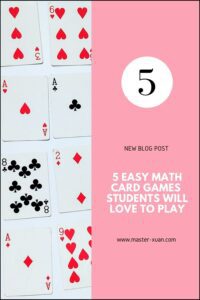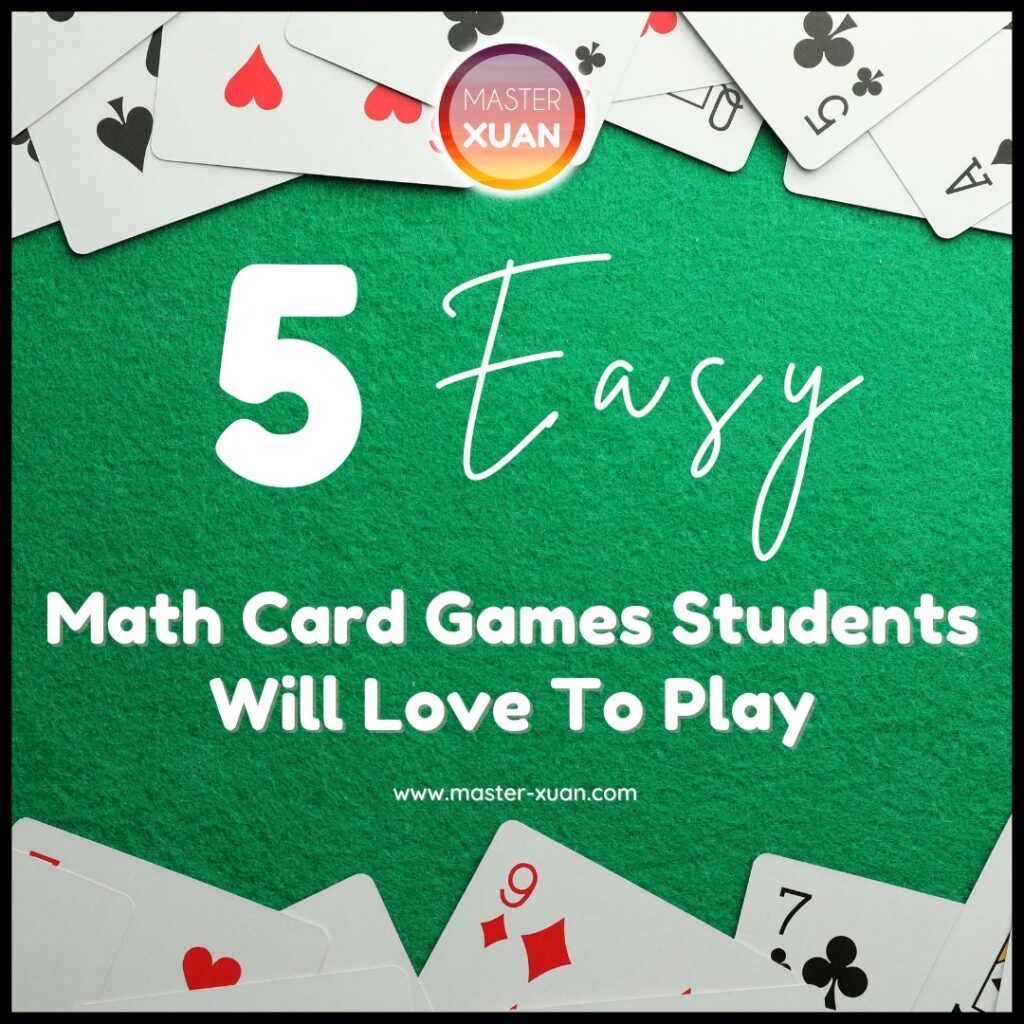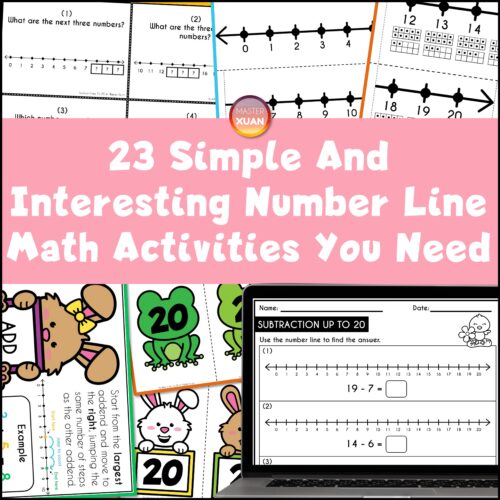Math card games can make students more excited about practicing basic math skills like addition and subtraction. All you need is a deck of playing cards.
These card math games are best for kindergarten, grade 1 or Primary 1. But even older kids will also enjoy these math activities with playing cards.
Disclaimer: I didn’t come up with these math card games and I may have changed the rules!
Blackjack
This is a popular and common game. But you may need to tread carefully on this as many people associate this game with betting and casinos. Though there is no gambling involved, some sensitive parents may frown when they know their kids are learning this game.
So it is important to emphasize to students that we are practicing adding to 21.
This is how the game is basically played.
Math Skills: Addition Up To 30
Players: 2 – 7
Objective: The goal of Blackjack is to beat other players by having a hand value as close to 21 as possible without exceeding it (going “bust”).
Setup:
- A standard deck of 52 playing cards is used. In Blackjack, the cards have the following values:
- Number cards (2 through 10) are worth their face value.
- Face cards (Jack, Queen, King) are worth 10 points each.
- Aces can be worth either 1 or 11 points, depending on which value benefits the player.
Gameplay:
- Each player is dealt two cards. Players can look at the cards and take turns making decisions regarding their hands. There’s only 1 chance to draw a card from the deck. Here are the options:
- Hit: Take an additional card to increase your hand’s total. You can hit as many times as you like, but if the total exceeds 21, you go bust and lose the round. Players need to keep hitting until they have a hand value of 17 or higher.
- Stand: Keep your current hand (if you have 17 or more) and end your turn.
Winning: The player with a hand value closest to 21 without exceeding it wins the round.
Variation:
For easier game play, you may take out face cards such as jack, queen, and king. Instead of giving two values to ace, just give it the value of 1.
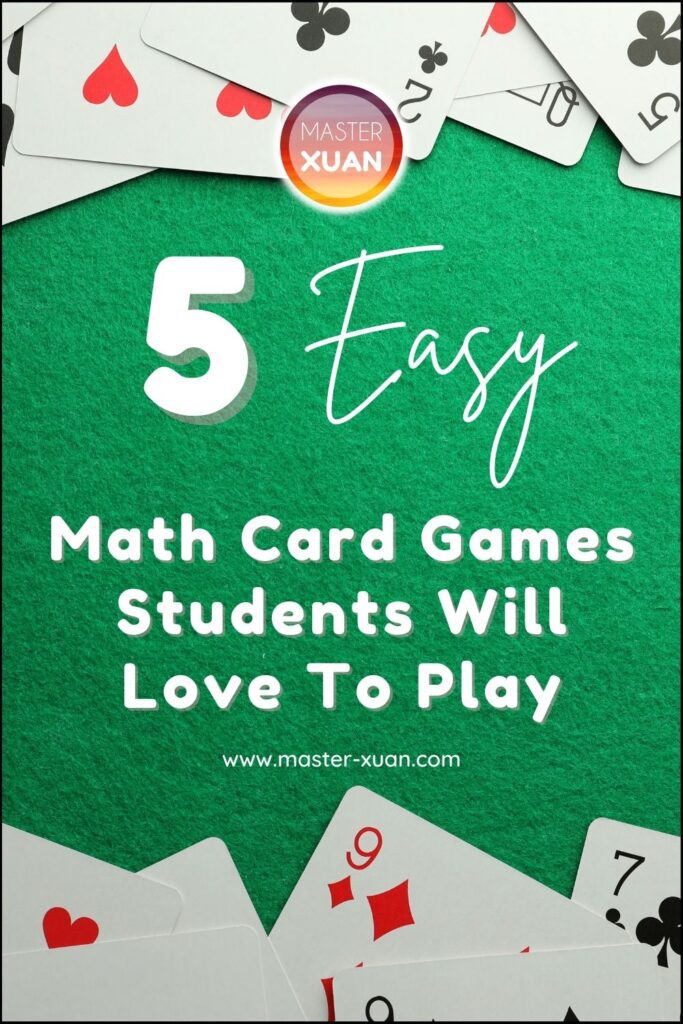

Go Fish: Pairs to Ten
My students love this group game. Be aware to emphasize players to keep their cards hidden from other players.
You can teach them strategies like remembering what other players asked for to know what cards they have.
As there is a luck factor involved, even weak students can win!
Math Skills: Addition To 10
Players: 3 – 4
Objective: The objective is to collect pairs of cards that, when their values are added together, equal 10.
Setup:
Using a standard 52-card deck, remove face cards (Jack, Queen, King) and the 10s. The remaining cards are valued as follows:
- Aces count as 1.
- Number cards (2 through 9) have their face value.
Deal five cards to each player. Players can look at the cards but keep them hidden from their opponents.
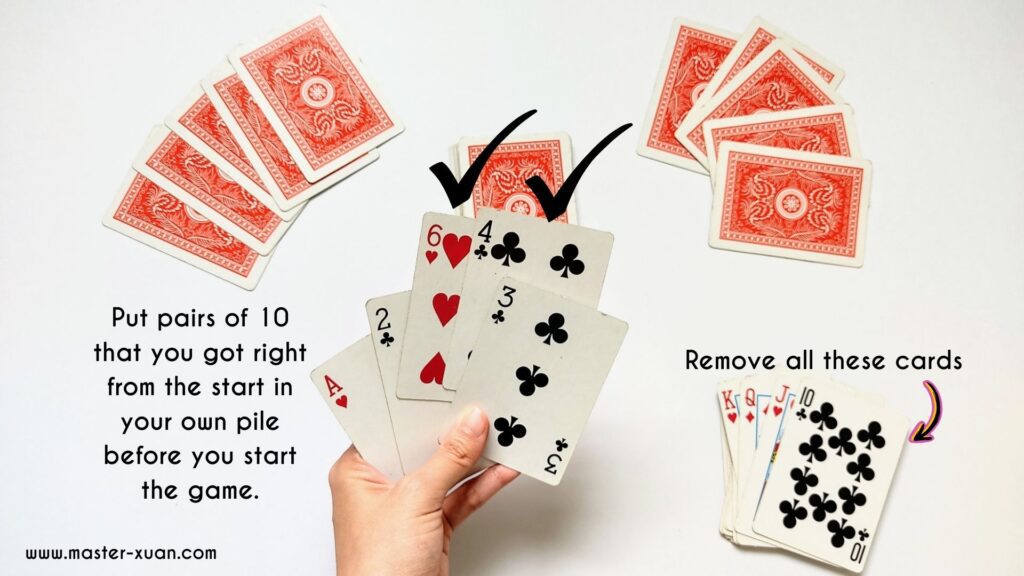

Gameplay:
Examine the five cards you’ve been dealt. Gather pairs of cards whose values add up to 10 points, like a 4 and a 6, and set them aside in a separate pile.
Decide who goes first (i.e. youngest or older starts first). Players take turns in clockwise order.
On your turn, request a specific card from another player. You can only ask for a card that, when paired with one of your own cards, would add up to 10. For example, if you have a 3, you can ask, “Do you have any 7s?”
If the player you ask has the requested card, they must give it to you. Place pairs that add up to 10 in your pile and take another turn.
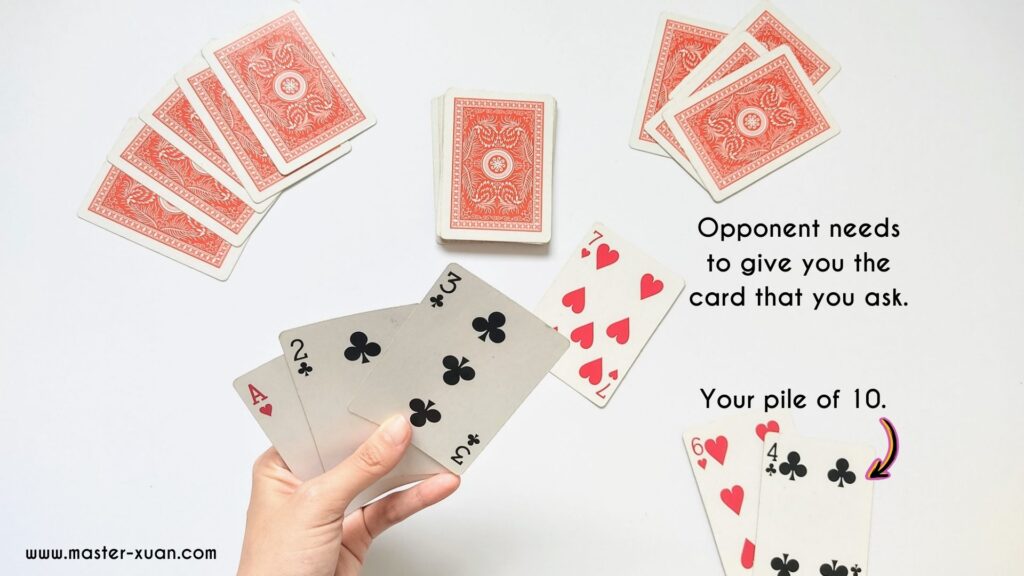

If the player you ask doesn’t have the card you’re looking for, they respond with “Go Fish,” and you must draw a card from the deck. Your turn ends as soon as you draw a card, even if it forms a pair with a card from your hand.
Play proceeds to the next player in a clockwise direction.
If a player has used all their cards, they can draw 2 cards from the deck. The player whose turn it is has the first draw. For example, if Player A and Player B both have no cards left in their hands, Player A draws 2 cards first, and then Player B draws 2 cards. If there are no cards left for Player B to draw, their turn ends.
The game ends when there are no cards left in the deck, and all the pairs that add up to 10 have been found.
Winning: The player with the most pairs of cards that make 10 wins the game.
Make 10
Math Skills: Addition Within 10
Players: 1-4
Objective:
For individual play: Your aim is to clear all the cards from the table.
For group play: Be the player with the most cards when the game ends.
Setup:
Using a standard 52-card deck, remove face cards (Jack, Queen, King) and the 10s. The remaining cards are valued as follows:
- Aces count as 1.
- Number cards (2 through 9) are worth their face value.
Place 20 cards face-up on the table.
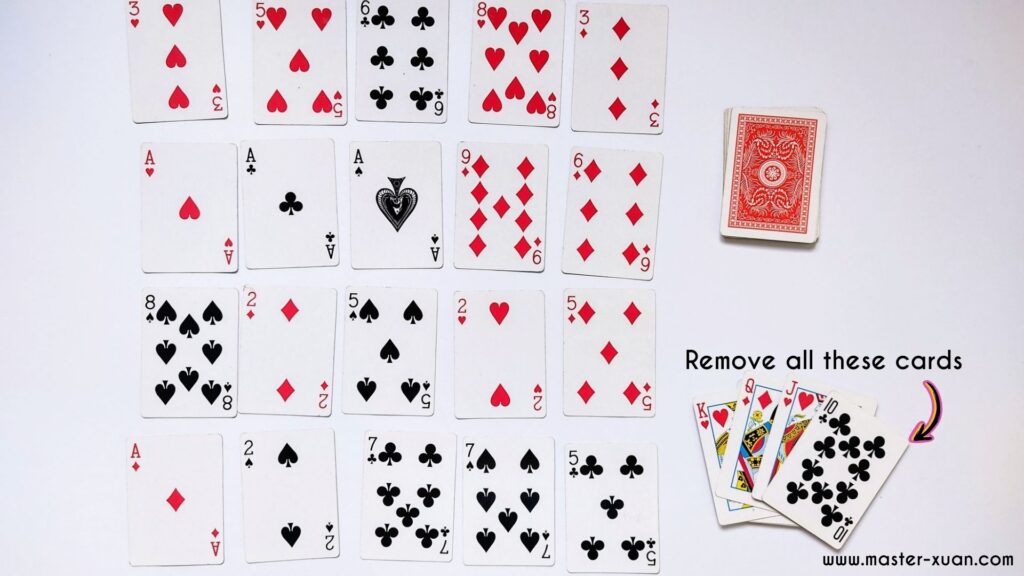

Gameplay:
The first player who spots cards that add up to 10 begins the game, and then players take turns in a clockwise order. (Or pick a card from the deck, the bigger number starts first.)
Players collect cards that, when added together, make 10, adding them to their winning pile. (No limit to the number of cards that add together.)
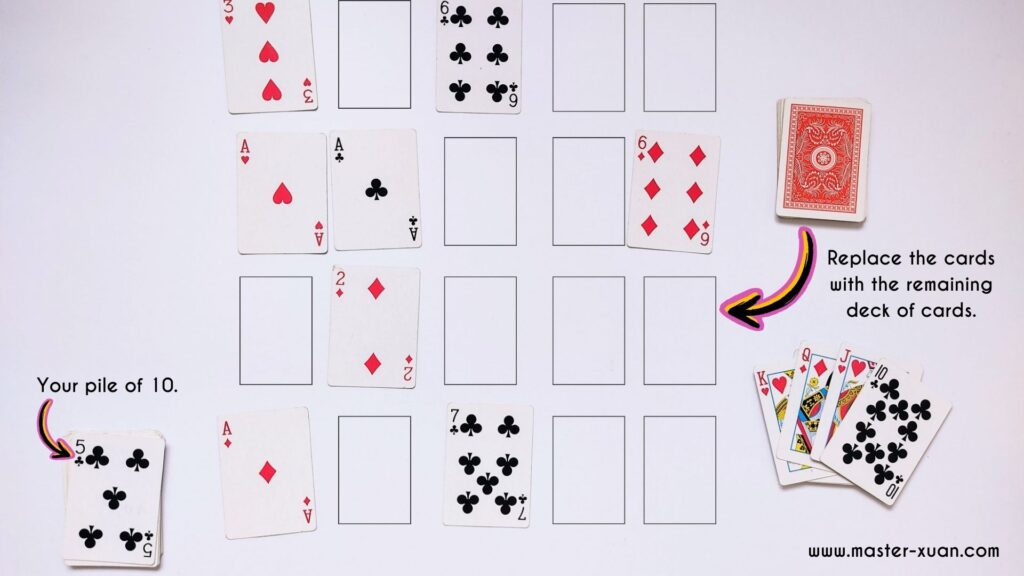

Or player need to fill the spots first before making another 10.
Fill the empty spots on the table with cards from the deck.
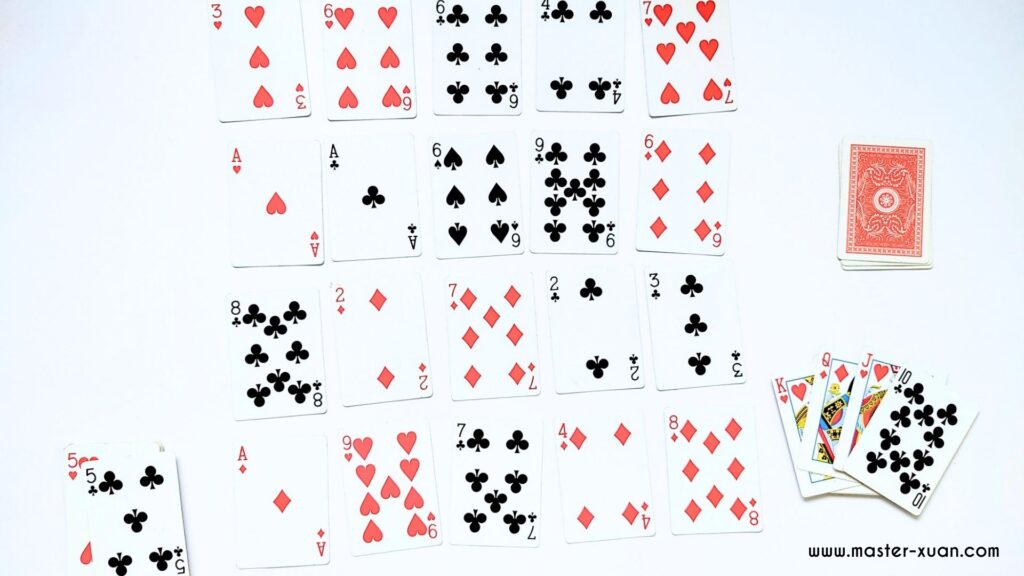

Winning: The player with the most cards at the end, when no more moves are possible, or when all the cards are collected, wins.
Variation:
Limit the combination of cards that add up to 10 to pairs. Players must find pairs of cards that add up to 10.
Stress Card Game
This math card game is appreciated for its fast-paced and challenging gameplay that sharpens players’ strategic thinking and quick decision-making. This makes it a popular choice for those seeking an exciting and intellectually stimulating card game.
Math Skills: Add and Subtract by 1
Players: 2
Objective: The goal is to be the first player to use all the cards in your hand.
Setup:
- Use a standard 52-card deck.
- Split the deck into two equal parts.
- Each player places 4 cards face-up in front of them (these are the 4 playing piles), and you can stack the same cards.
- Players hold the remaining cards in their hands. They cannot see the cards.
- Both players place one card from their hands face-up in the middle, side by side.
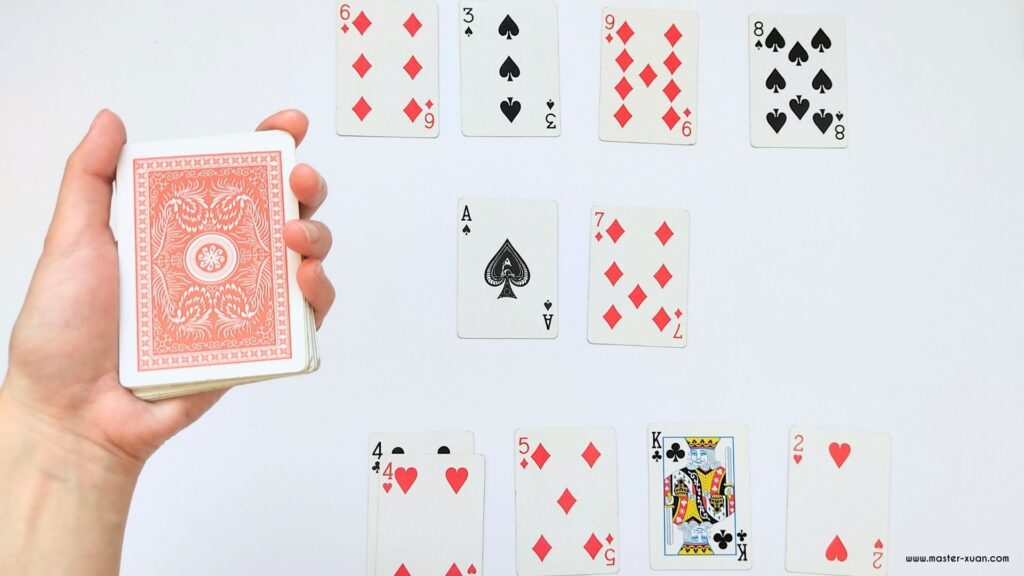

Gameplay:
Players need to place cards from the 4 piles in front of them that are either one rank higher or one rank lower than the cards in the middle. The order goes like this: A, 2, 3, 4, 5, 6, 7, 8, 9, 10, J, Q, K, A.
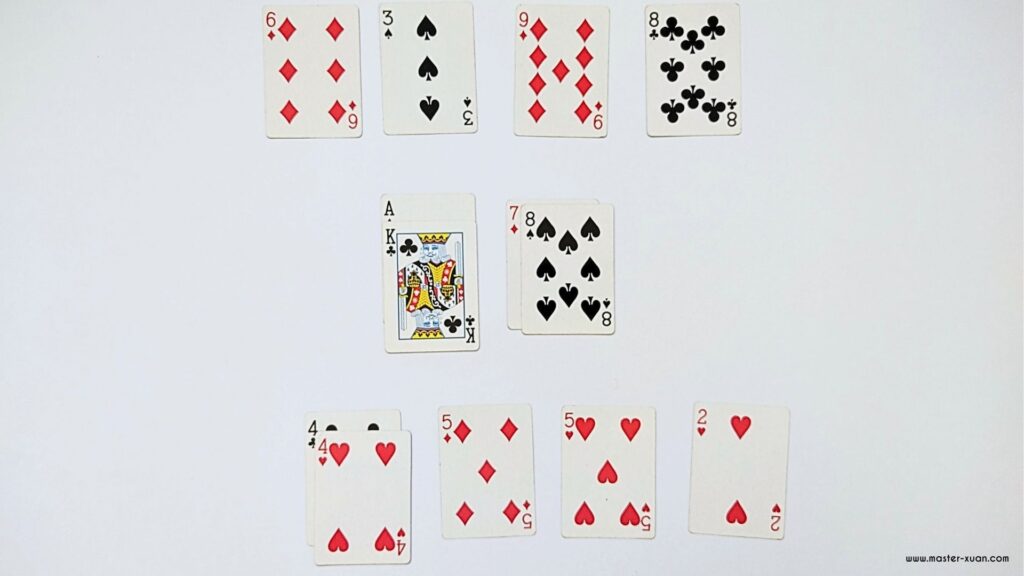

You can only move cards from your 4 piles to the middle piles, and you can add cards to any one of the empty 4 piles.
If neither player has cards to place in the middle, both players must draw a card from their hands and place it in the middle.
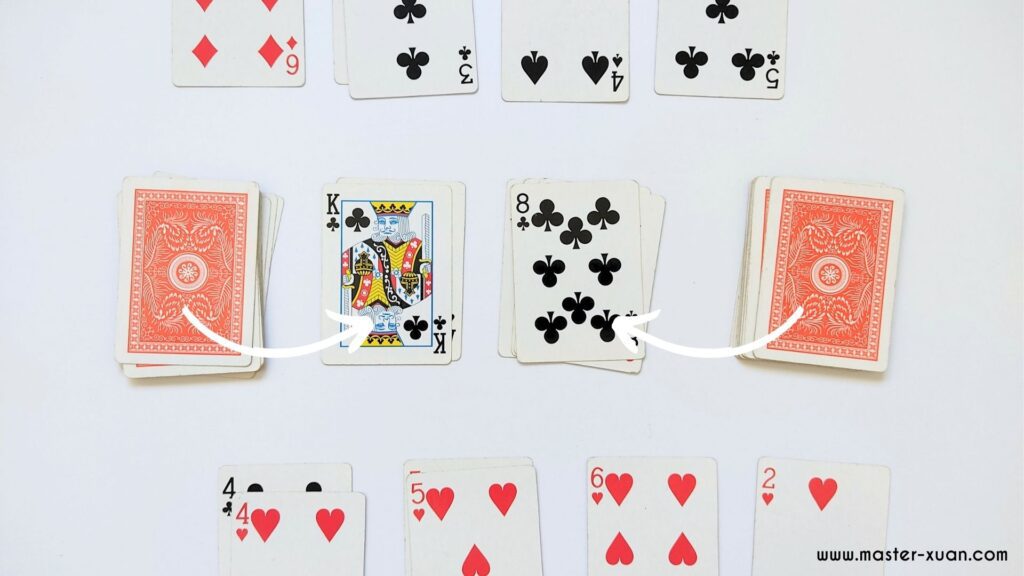

In a similar fashion to the game of “Snap,” if there are matching cards in the middle pile, the player who swiftly slaps both of them and exclaims “stress” forces their opponent to collect all the cards from the middle pile.
Towards the end of the game, if a player has no cards left in their hand, they can take a card from their opponent’s hand to place in the middle (this means the opponent contributes 2 cards to the middle piles).
If, towards the end, both players have no cards left in their hands but still have cards in the 4 piles, the players can shuffle the middle piles and take 2 cards from it to place in the middle again.
The game concludes when one player successfully uses up all the cards in their hand.
Winning: The player who used up all the cards first wins.
Variation:
The game can also end when players have placed all their cards in the 4 piles, have no more cards in their hands, and are unable to place any more cards in the middle piles.
You can remove the gameplay of slapping similar cards in the middle.
Note: Players can only use one hand to place the cards.
Difference of 3 & 4
My kindergarten 2 student was reluctant to practice subtraction until we played this math card game!
There aren’t many subtraction card games that are as entertaining as this.
Math Skills: Add and Subtract within 10
Players: 2
Objective: The goal is to take the most 3s or 4s cards.
Setup:
Using a standard 52-card deck, remove face cards (Jack, Queen, King) and the aces.
Take out the 3s and 4s and place them face-up in between the players. These are the winnable cards.
Deal four cards to each player. Players can look at the cards but keep them hidden from their opponent.
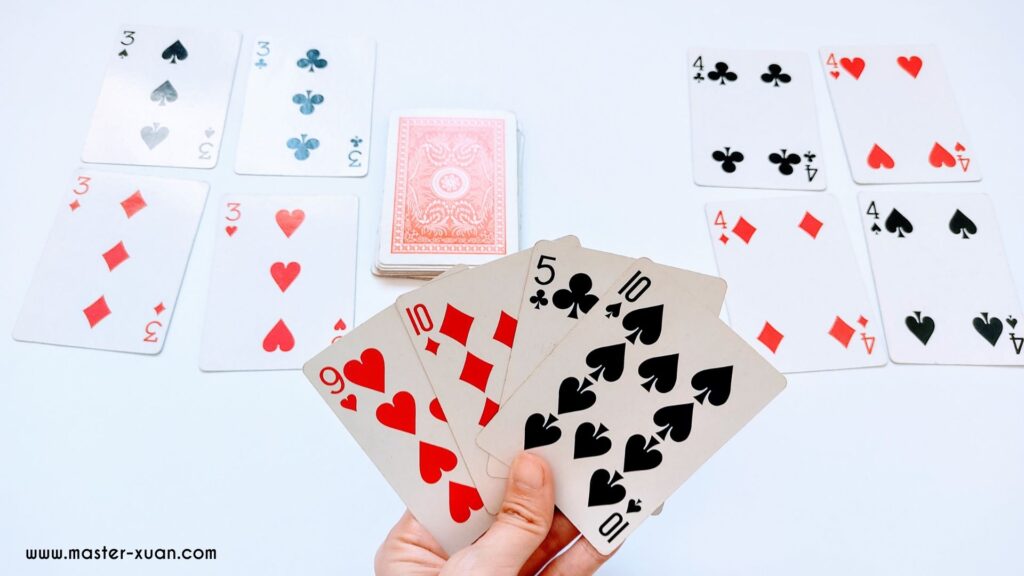

Gameplay:
- Decide who goes first (you can use a simple method like rock-paper-scissors to determine this).
- Players must find a pair of cards that, when subtracted, equals either 3 or 4 in order to collect the winnable cards.
- When you find them, you need to say the subtraction out loud and correctly. For example, they should say, “5 minus 1 equals 4.”
- The player then places the winnable cards in their pile and draws two new cards from the deck to end their turn.
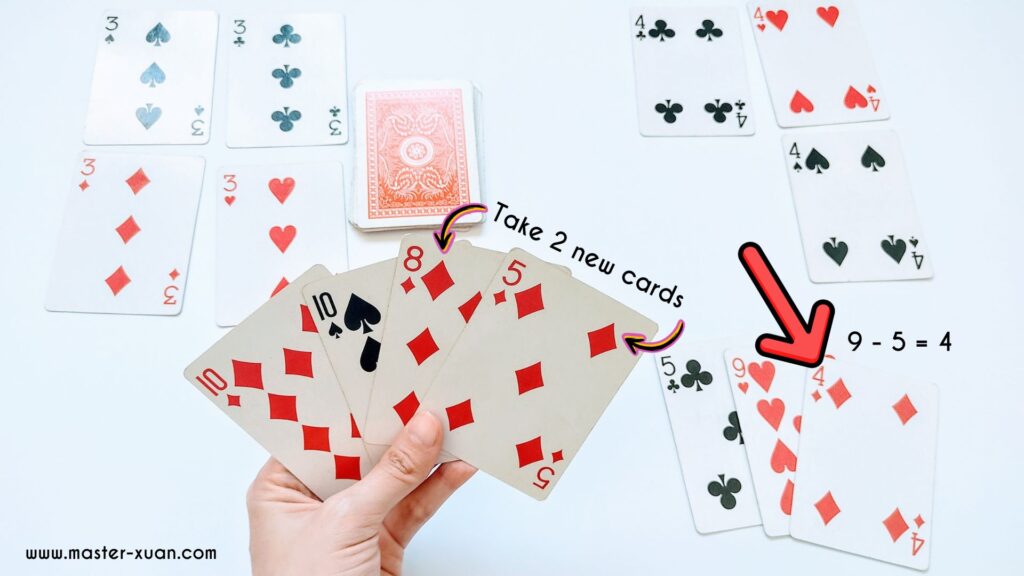

- If a player doesn’t have any possible pairs, they must discard one card face down and then draw one card from the deck.
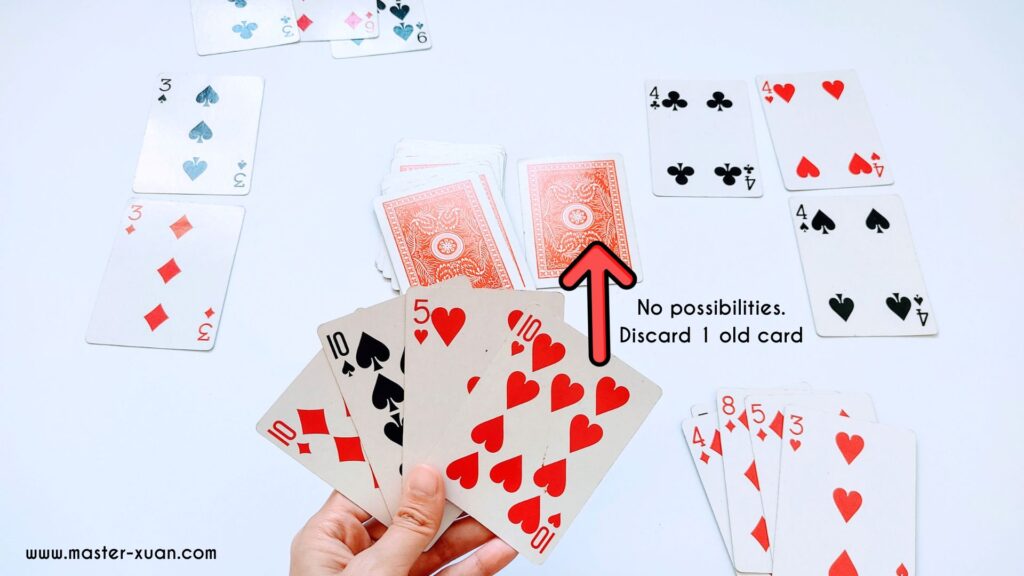

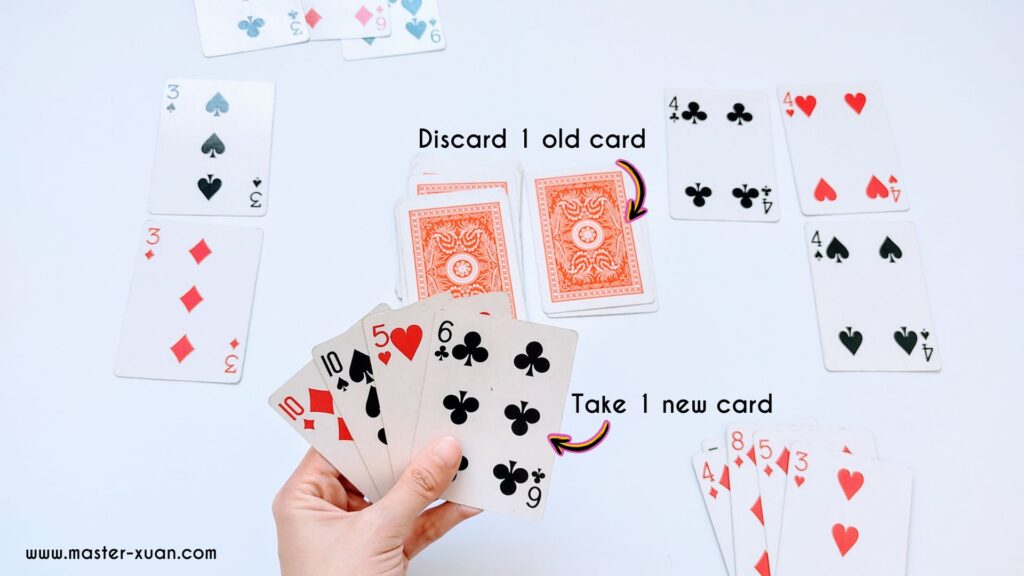

- An easy way to remember is, once a player draws any cards from the deck, their turn ends.
- The game ends when all eight 3s and 4s have been won, or when the deck has been completely used, and no more 3s or 4s can be won.
Winning: The player with the most 3s and 4s in their collection is the winner.
Variations:
- If players did not say the subtraction statement correctly, they can’t take the winnable cards.
- If players don’t have any possible pairs, they can choose to draw one card from the deck before deciding which card to discard.
- You can attempt to shuffle the discard piles and use them as a makeshift deck to check if any more 3s or 4s can be won.
Final Thoughts
In conclusion, math card games are a fantastic way to make learning basic math skills, such as addition and subtraction, enjoyable for students.
These games require nothing more than a standard deck of playing cards and are ideal for children in kindergarten, grade 1, and beyond.
While I didn’t invent these math card games, I may have adjusted some of the rules to better suit educational purposes and my students.
These games not only boost math skills but also foster a love for learning by turning education into entertainment. So, grab a deck of cards and enjoy hours of fun learning with these math card games!
If you need more fun practice, consider this self-checking winter maze: Add And Subtract Within 20 Mazes Worksheets and Boom Cards.
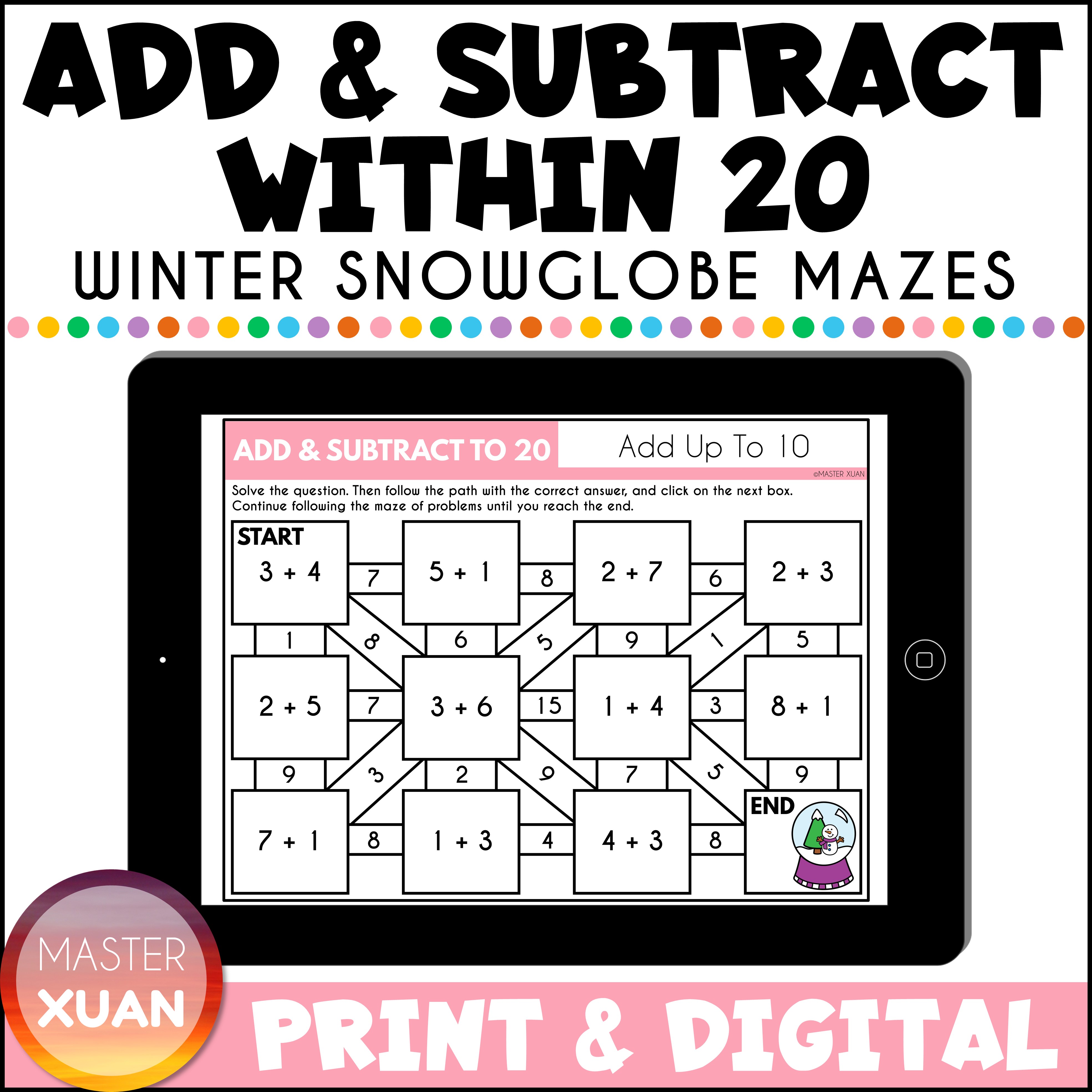

Related Read: 5 Fun Printable Math Board Games To Engage And Educate Primary Students
